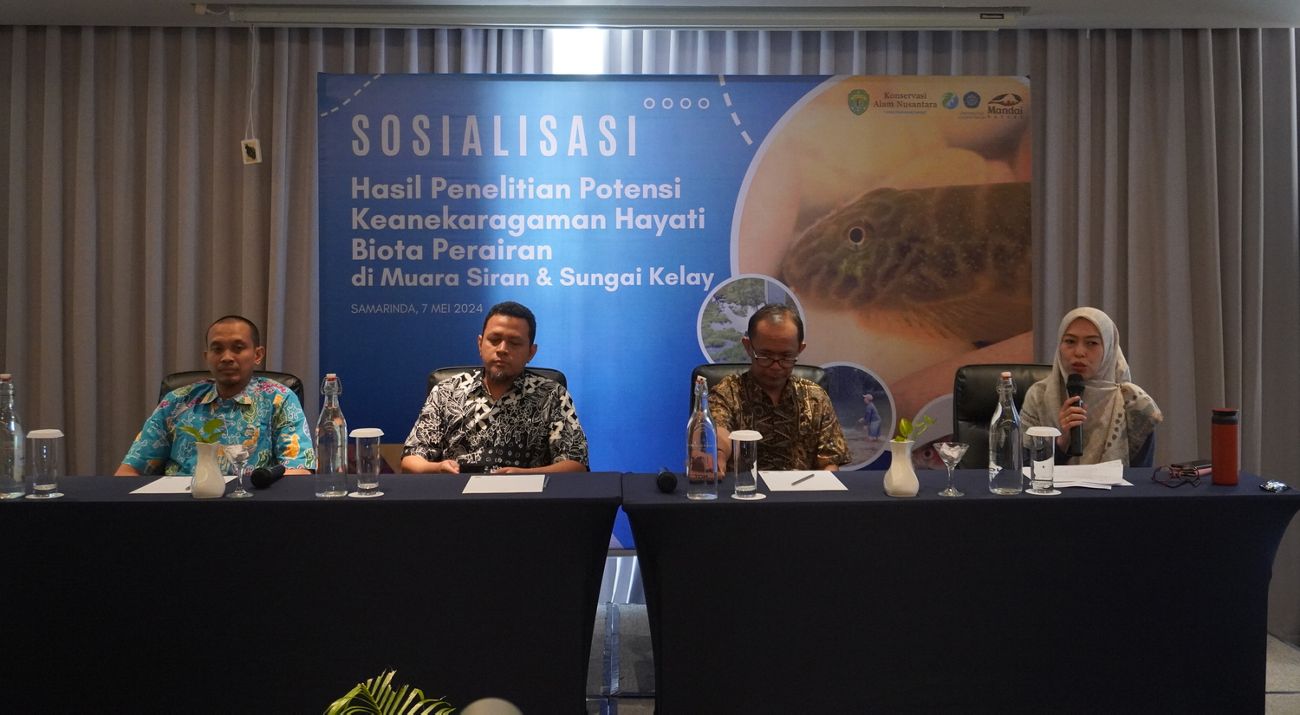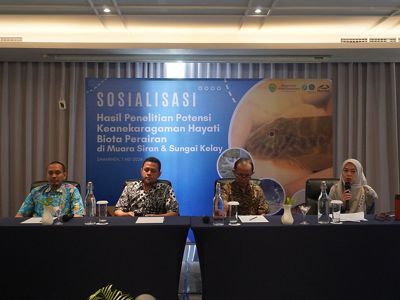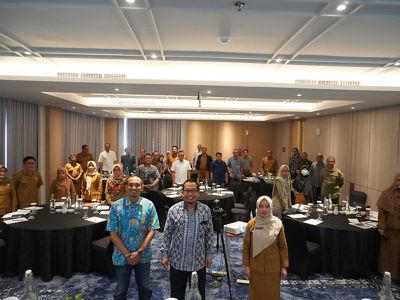
Media Contacts
-
Retno Sari
Content and Publication Specialist YKAN
Email: retno.dianingsari@ykan.or.id
East Kalimantan is rich in biodiversity from its forests and seas and its freshwater habitats. "We found a fish species called atuk sembelung (Pangio alternans), an endemic Kalimantan fish that is endangered (Endangered - EN) in the Kelay River, Berau Regency," said Donan Satria Yudha, a lecturer at the Faculty of Biology, Gadjah Mada University (UGM) Yogyakarta, during the Dissemination of Research Results on the Biodiversity Potential of Aquatic Biota at the Estuary of Siran and Kelay River, in Samarinda, on May 7, 2024.
A group of researchers from UGM and the Indonesian Nature Conservation Foundation (YKAN) researched the biodiversity of freshwater biota at the Estuary of Siran and Kelay River in Samarinda throughout 2023. Sampling was carried out using purposive sampling methods, both passive and active, for approximately ten days. In passive sampling, researchers used traps to collect samples, while in active sampling, researchers directly collected samples using various capture tools. Today, a dissemination of research results was held, attended by stakeholders including the East Kalimantan Provincial Department of Marine and Fisheries; Kelay Subdistrict Government, Berau Regency; Muara Siran Village Government, as well as representatives from development partners and relevant local government agencies.

The initial premise of this research was that freshwater ecosystems (rivers, lakes, and swamps) also harbor high biodiversity. In general, their diversity encompasses one-third of all vertebrate species. However, globally, the populations of monitored freshwater biota have declined by an average of 83% since 1970—much faster than terrestrial or marine biota. There has been relatively little research on freshwater biota issues for Indonesia, and East Kalimantan specifically.
The research results indicate that the waters of the Kelay River, located in the PT Wana Bakti Persada Utama (PT WBPU) area, serve as a habitat for 39 fish species and five crustacean species. In addition to finding an endangered fish species, researchers also found a vulnerable species, the atuk bensong fish (Barbodes bunau). According to previous research data (Daniels, 2020), atuk sembelung fish are usually found in the middle reaches of the Mahakam River Basin, recorded in a peat river flowing into the Mahakam River. As for the atuk bensong fish, its habitat is known to be easily found in the Seturan Malinau Basin, North Kalimantan. Therefore, Donan stated that their presence in Berau Regency is new information. "This finding indicates that the waters around PT WBPU are in a natural condition, not experiencing severe disturbances, and serve as suitable habitats for aquatic biota," he said.
Based on local information, there are still fish species that have not been found during the research, namely catfish (Pangasius sp.) and eels (Anguilla sp.). This indicates that the list of fish species could still increase if the survey continues. The habitat of these waters has been proven to contain a high potential for biodiversity of fish and crustaceans, including the potential discovery of new species. This potential for future research and discoveries is a compelling reason to continue our efforts in understanding and conserving the biodiversity of freshwater biota in East Kalimantan.
In the landscape of Muara Siran Village, the research team found 57 fish species and five crustacean species. Of these, 51 fish species and four crustacean species are native to Indonesia, while the rest are introduced species (alien species). "Some are invasive, and some are considered foreign," said Rury Eprilurahman, a member of the research team from UGM. Rury, a lecturer at the Faculty of Biology, UGM, stated that invasive species such as tilapia, common carp, and goldfish are easily found in the Muara Siran Village area and its surroundings, as for foreign species like catfish, Siamese fighting fish, and gourami.

Seeing the emergence of these foreign species, Rury stated that more socialization about their future impacts is needed. "Introduced species can be threatening to native ecosystems and species conservation," he said. He suggested prohibiting the release of foreign species in the Muara Siran Village area and its surroundings. Muara Siran Village still has well-preserved lake and peat swamp areas in East Kalimantan. The peatlands in this village are water recharge areas and peat swamp forests with the largest kahoi tree (Shorea balangeran) formations in East Kalimantan. The urgency to protect these areas and their biodiversity is clear, and immediate action is needed to ensure their sustainability.
Deputy Chairman of the Wahana Gerakan Lestari Indonesia Foundation, Susilo Irwan Jasmono, said that residents around the location have only utilized them for consumption. "The potential for ornamental fish and special interest tourism is very high in East Kalimantan," he said at the same event. Ornamental fish have a higher economic value than consumable fish. Irwan explained that ornamental fish are sold per piece. "The price of one ornamental fish can be equivalent to one kilogram of consumable fish," he said. He suggested developing a master plan for the management of freshwater biota. "The sooner its management is arranged, the more assured its sustainability will be,"

"This research is the first step in documenting the biodiversity richness of freshwater ecosystem biota in East Kalimantan," said Niel Makinuddin, Senior Terrestrial Program Manager of YKAN, at the same event. Freshwater biota often escape the conservation chain because we are too accustomed to finding them in markets and having easy access to freshwater areas. According to Niel, the topography of Kalimantan Island, surrounded by rivers and large lakes, is a haven for freshwater biota. Niel hopes that with the results presented today, it will become a policy recommendation to save endemic species, especially those already endangered, and simultaneously strengthen the implementation of the Green Growth Compact (GGC) in East Kalimantan. "East Kalimantan is blessed with various biodiversity; let's start by recognizing what still exists, as shown in this research," said Niel.
Yayasan Konservasi Alam Nusantara (YKAN) is a scientific-based non-profit organization that has been present in Indonesia since 2014. With the mission of protecting lands and waters as life support systems, we provide innovative solutions to realize the harmony of nature and humans through effective natural resource management, prioritizing a non-confrontational approach, and building a network of partnerships with all stakeholders for a sustainable Indonesia. For more information, visit ykan.or.id.

